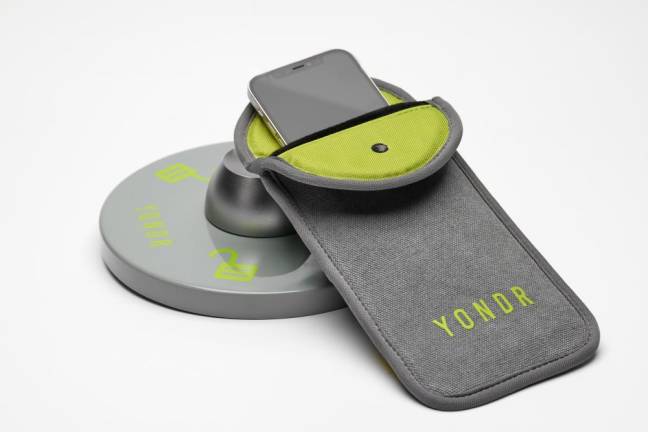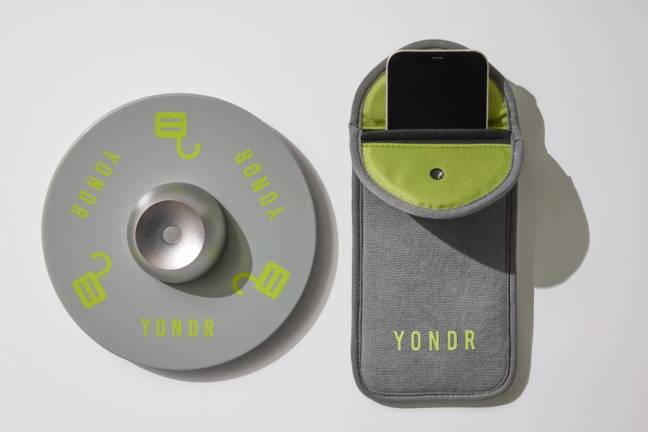As screen time soars, high schools turn to Yondr bags and phone cubbies
EDUCATION. To improve peer relationships and decrease classroom distractions, some area high schools implemented strict cell phone policies through the use of Yondr bags to lock away students’ devices for the entire school day. Others are trying to teach students how to use smartphones responsibly.



Should schools ban cell phone use among students?
In a survey completed by more than 600 local readers, 73% said yes. But they disagreed about the extent to which devices should be restricted.
Some want students’ phones locked away for the entire day, placed somewhere they can only be accessed by a faculty member.
Readers on the other end of the spectrum said students should be able to always have their phones accessible in case of an emergency.
Pike County, Pa., resident Kevin Holian is part of the 27% who don’t think phones should be banned at all. Instead, he said districts should focus on teaching students how to use them safely and properly. He compared banning student phones to banning certain books. “It’s too puritanical, too punitive, and I think it’s unhealthy,” he said.
‘When are they sleeping?’
To Warwick, N.Y., mom Heather Franklin, it’s the cell phone use that’s unhealthy. She welcomes any measure to limit screen time and noted how studies, including a 2021 report from Common Sense Media, show that the average teenager spends nearly nine hours of screen time a day.
“When do they sleep? They’ve got seven hours of school. They’ve got two hours of sports. They’ve got two hours of homework. When are they sleeping?” she said. “It’s affecting their sleep; it’s affecting their mood. It’s also taking away from the time where they would develop the most social skills with face-to-face interactions with other kids.”
"It’s a complete distraction for these kids," added Amy Wohl, a social worker based out of Goshen, N.Y. "I cannot tell you how much anxiety it breeds, it’s just incredible to me."
Distracting students
Local districts, too, are split on how to manage smartphone use by students. Most have general policies that phones are not allowed during instructional time unless under the direction of a teacher. Some schools, including Newton, N.J., let teachers set their own rules regarding cell phones in the classroom; some educators have students put their phones in assigned cubbies at the beginning of class.
“A common discussion I have with principals when we get together with multiple schools is that since the pandemic, cell phones have definitely become more of a distraction than they were pre-pandemic,” said Jonathan Tallamy, principal of High Point Regional High School in Sussex, N.J. “It’s up to us to help educate around those things, in terms of when an appropriate time to use their cell phone is.”
Monroe-Woodbury School District is also focused on trying to teach students how to use phones responsibly. “We have digital citizenship lessons sprinkled throughout various curriculum and content areas across the school district,” said Assistant Superintendent for Curriculum and Instruction Eric Hassler.
At High Point, students’ phones are supposed to be turned off during class time, but they have access to their devices during free periods such as lunch and study halls.
“It’s an uphill battle,” Tallamy said.
He finds the school’s policy to be “marginally effective,” noting how smartphones have become such a central part of lives for teens and adults alike.
“Go into an elevator. What do you see? Everyone’s on their cell phones. Go to the doctor’s office. What do you see?” he added. “Everybody’s on their cell phones.”
Last spring, Warwick Valley High School got phone holders for each classroom, where students surrender their phones at the beginning of each period.
“As an educator, I have their cell phone spots tabulated with names on them and I know exactly who surrendered one or who didn’t,” said Warwick Valley High School science teacher Jason Touw. He said the new system has curbed student distractions and set clear expectations about when cell phone use is appropriate.
“It doesn’t matter if you said you’re doing homework on it, or if you said you were playing solitaire on your phone – it is not supposed to be out during any study hall or any instructional period at all.”
Phone-free environments
The high schools in Middletown and Newburgh, N.Y., took a different route in 2023, essentially banning phones altogether by ordering Yondr bags for each student.
At the beginning of each school day, high schoolers put their phone in their Yondr pouches, which they can carry from class to class, but the pouch remains sealed and inaccessible until the end of the day when students tap them on a magnetic base to unlock their devices.
Middletown did it to support students both academically and mentally after the pandemic. Despite adding extra social workers and mental health services, they still found students were mentally struggling – and often glued to their phones.
“We started with the first semester telling young people and their families that it would just be our expectation that phones were away ... that we would try this strategy and see if we could close the gap on the mental health needs for our young people by doing this,” said Middletown Superintendent Amy Creeden.
It didn’t work.
“We were seeing our young people’s mental health suffer, their executive functioning skills suffer, their ability to develop relationships and make connections,” Creeden said. “So we sort of leapt and said: We’re going to do this. We believe in the research behind it.”
Through funding from the Every Student Succeeds Act, the Middletown school district spent $46,300 to implement Yondr pouches at the high school, which serves 2,700 students. Administrators say it paid off – so much so that they’re looking into introducing Yondr pouches at the middle school level.
After implementing Yondr pouches last winter, Middletown’s graduation rate was the highest it’s ever been at 92.07%. This past semester, the district saw a record-breaking winter graduation rate as well.
Beyond the numbers, Middletown educators are reporting increased communication skills and engagement among students in the classroom.
“When young people know that phones are an option, it’s always competing for attention,” said Middletown’s Associate Principal William Donohue.
Despite the positive outcomes administrators are reporting, some parents doesn’t think the Yondr bags are worth the investment.
“Waste of money,” said Celeste Favors, whose daughter graduated this winter. “And kids break them. They know how to get in and out of them.”
Creeden was quick to note that young people are “capable, contributing members of our world – and they oftentimes find out how to jailbreak all sorts of systems that we put in place.
“Just because not all of our young people are following it to the letter of expectation,” she added, “doesn’t mean that we give up and don’t provide the benefit to the vast majority.”
Resistance, questions, response
The transition to Yondr did not come without resistance. It goes without saying that students are generally reluctant to unplug.
“I don’t think the use of the Yondr bag should be done in schools,” said Monroe-Woodbury sophomore Zayed Kadir when asked about the topic.
He raised questions the same questions that Middletown families were quick to ask as well:
What if there’s a school shooting?
What if a student is having a medical emergency and needs to contact a parent?
What if a student is having some kind of issue they do not want to disclose to school staff, but need to contact their parents about?
“Anytime you make any type of change,” Creeden said, “it is uncomfortable for adults and young people, but we had really done so much thinking about what potential roadblocks could be.”
The school made it possible for parents and students to email one another through students’ Chromebooks throughout the day. There are also “safe spaces” set up throughout the high school where “if they want to access their cell phone they absolutely can, no questions asked ... they can utilize the phone if they need to contact a parent or guardian,” explained Executive Principal Lynnette Williams.
In terms of potential emergencies such as school shootings and students not having access to their phones, “it was definitely a concern raised by families,” said Creeden. “But I don’t think it’s one that is a concern universally shared by local officials in law enforcement and emergency responders, right? Because the issue is that in emergency situations now, the flow of information is happening so quickly that there is more frequently tons of misinformation than accurate information.”
Considering this, and parent feedback, the district added medical grade scissors to each classroom’s emergency kit to offer “that same safety and security feeling so that if there was a catastrophic emergency, young people could cut open their phone pouches and have access to emergency support.”
Anti-social media
Smartphones have not just become a distraction from the learning. When conducting interviews for this story, two administrators from different school districts told our reporter the same anecdote: kids are spending lunch and free periods scrolling on their phones instead of engaging with one another.
“I had a discussion,” said Tallamy, the principal of High Point Regional High School, “with seniors that were in study hall. They weren’t doing anything wrong or inappropriate. There were six of them sitting at a study hall table on downtime, but they all had their cell phones out in front of them while they’re having a conversation.”
“I said ‘Now wouldn’t it be nice to put your cell phones down for 10 minutes, and have an engaging, eye-contact-conversation?’"
Middletown Superintendent Amy Creeden said, prior to ordering Yondr bags for high schoolers, students were in a constant state of “checking, checking, checking (their phones), texting walking down the hallway, not even looking up and engaging with each other. In cafeterias, there’s a table of four people sitting with one another, yet nobody’s speaking to each other.”
But now “when you see our young people in the hallway, they’re conversing with each other,” said Middletown Principal Williams. “They’re having fun. They’re at lunch tables, they’re eating together ... they’re communicating. They’re playing games.”